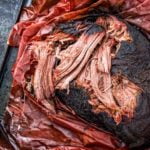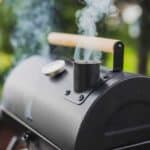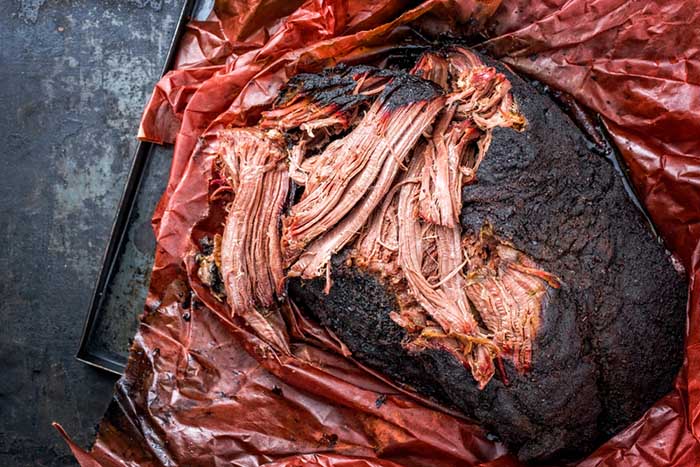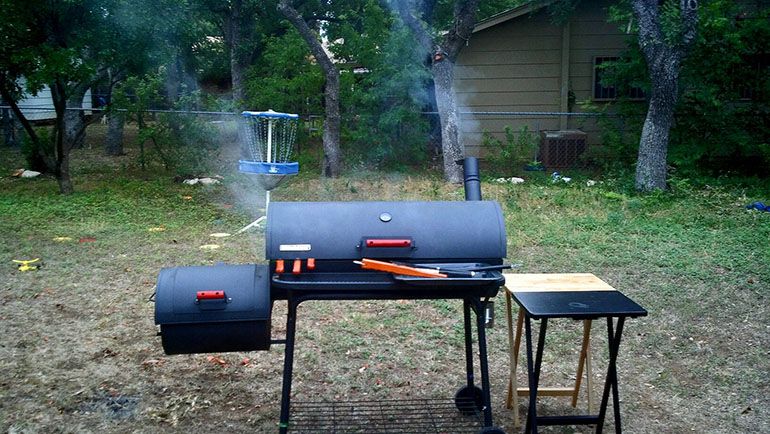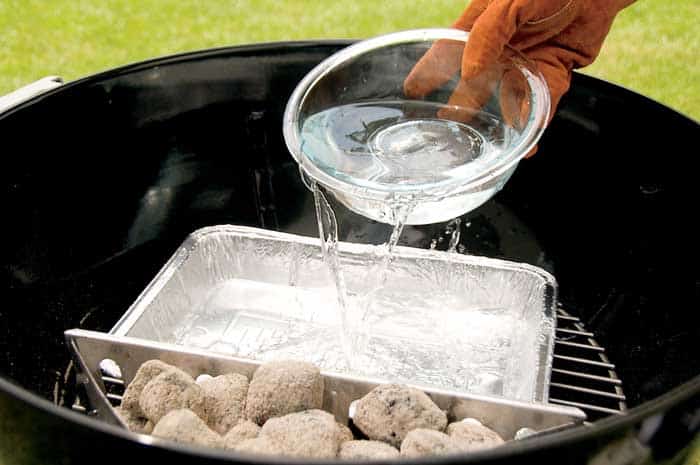The BBQ stall is a problem familiar to every pitmaster. Knowing how to overcome it is the key to perfect smoked pork butt and beef brisket. Find out what causes the BBQ stall and how to beat it with our barbecue smoking guide.
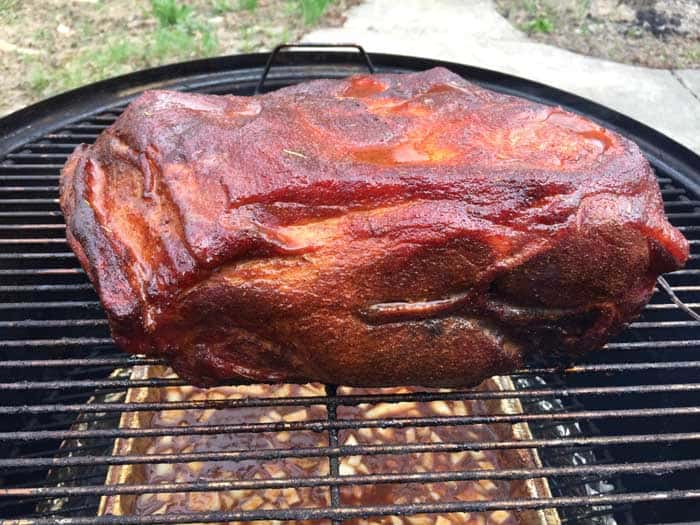
If you have ever smoked pork butt or beef brisket, you have encountered a strange phenomenon. Your meat is cooking nicely when, all of a sudden, the internal temperature hits a brick wall.
You try cooking hotter, wrapping your meat in foil, or even cutting up the food. None of these work. So what’s going on?
The good news is that this isn’t a weird anomaly. In fact, It’s called the stall, and it’s something that many experienced pitmasters and barbecue pros go through to this day.
Today we’re going to explain what the stall is, explain the meat science behind it, and show you the best ways to avoid or beat it. Let’s get into it!
What is the BBQ Stall?
The stall is a devil that is known by many names in the barbecuing community. It is also referred to as the plateau or the zone. This phenomenon typically happens when you are smoking a large amount of meat at a low temperature for quite a long time. What causes the meat to stall is that there is a certain amount of moisture on the inside of the meat, whose temperature gets to 150 Fahrenheit to 170 Fahrenheit.
When that moisture reaches this point at some, it may start failing to increase any further. Unfortunately, when this happens, it takes a couple of hours to resolve. You will most likely be very confused, and use all the thermometers you must inspect the grill’s temperature. Many people even resort to checking if the grill is connected to the power source.
I assure you that the grill is working. The meat has simply stalled. This is an obvious dismay situation because people are so excited about the food, and it is just not coming. As the head barbecue master, you cannot answer the people and probably are fearing that a mutiny could erupt at any moment.
Well, fear not because you can explain to them that what is happening is that the meat is sweating. Believe it or not, meat perspires when it reaches a high temperature. As the meat begins to sweat, this sweet goes up into the grill and evaporates, thereby cooling down its temperature.
This problem can last for even up to six hours, which only adds more frustration to the barbecue master. The fact that you find inside whatever juicy meat you are cooking, normally referred to as collagen, is what will be required to absorb the heat to prevent the meat from sweating. When cooking a finely cut prime steak, there is often not much fat on this product, meaning that the collagen levels are insufficient to prevent the meat from sweating.
How does the stall happen?
You might be wondering how does the stall occurs?
Scientists have dubbed this evaporative cooling and hypothesize that this is because of meat being 65% water and making use of a slow smoking grill. Often when people smoke or slow cook, they do this with a sizable amount of meat. When you combine these two features, you can begin to understand how it works. Imagine yourself putting a huge pot of boiling water on the grill to be smoked.
At the temperature you are smoking the meat, how long do you think that temperature would take to boil such a huge pot of water. Now when you Have answered that question try to put it in the context of meat. The stall occurs when the smoke is now trying to heat up the water that resides within the meat.
Therefore, sometimes it feels like the temperature stops moving or even decreases further. When this happens, you will check the grill’s temperature and see that it is at the level you set it at. An essential aspect of this problem is that once the stall is over, the temperature can begin to pick up quite quickly.
This is important because often, people compensate for the store by raising the temperature of their grill. When you do this, you should always be checking to be aware of when the stall ends. If you raise the temperature and go back into the house to chat with your guests, you may come out to find the meat completely burnt because it came out of a stall, and you were not there to reduce the temperature.
This can be tricky and demoralizing, but it should not stop you from enjoying a meal that you worked so hard for. If you are planning on raising the temperature to combat this phenomenon, you should ensure that you can come back and check on the meat roughly every 15 to 30 minutes.
Related Factors
How big is the meat you want to cut?
It is natural that obviously, the bigger the meat you want to smoke, the more time it is going to take to get done. By this same conclusion, we can assume that the bigger the meat, the longer the stall will be. What you must consider when you want to smoke a piece of meat is both its density and surface area.
In simple English, I mean how thick the meat you want to smoke. a piece of juicy steak will take longer to cook if it is dense. An example of this is if you smoke or grill leg of lamb. There will be a large water concentration at the center of the lamb leg that will most likely cause the barbecue to store. This is different from if you have a juicy steak that has been cut flat and spread out across the grill. If your meat has been cut in this way, water evaporation will take place much faster than if the meat is dense.
What kind of barbecue product do you have?
It is no secret that the kind of barbecue grilled that you used to smoke your meat will impact the amount I have stall you experience over its lifetime. If you have managed to acquire a barbecue grill that has prioritized airflow throughout the grow, then you will experience a smaller stall than those who have a grill that is sealed up.
This is because airflow works well to energize evaporation. If you check your product’s design and notice that it has a fan, such as you will see in most pellet smokers, you are on the barbecue gods’ good side. If you are unfortunate and your smoker does not have good airflow, you may end up having to compensate for this by continuously opening your grill on your own.
Increasing humidity
Another important factor that could be plaguing you is a lack of humidity inside your barbecue grill. Humidity is very important to maintain temperature. That is why most grill manufacturers ensure that there is not a large amount of moisture lost.
Earlier, when we spoke of putting a pot of water inside the grill to smoke it, I want you to re-imagine that. Putting a small pan or pot of water inside the grill can help to maintain the humidity within. This trick also benefits the food you are making because it enhances the general smoky flavor that your meat will be expected to have.
How to Outsmart the Stall
Now we can get to the juicy part of the article. Let us look at two ways that one can use to beat the ever-bedeviling stall.
Use a blanket
By adding a blanket in this scenario, I am referring to aluminum foil. To beat the stall, you can wrap your meat in aluminum foil and then begin to smoke it. This is a way to lock in moisture within the grill. If you do not understand the science behind it is let me give you an example. Imagine if I wrapped you in plastic and made you run down the Hill.
You will be sweating throughout that procedure, but no sweat or temperature will be lost in that process. You will also not begin to get cooler because you are wrapped in a plastic bag. The heat shall be compounded. Now, if I make you run in the sun, it is even hotter. This is the same concept that we are applying here.
You can even make the best of this and add different juices or marinades inside the aluminum foil and wrap it in there with the meat. It is a common practice to add beer or fruit juice. This is a great way to get around this problem, but it does have a disadvantage. Many people enjoy the crispy or charcoal exterior of a smoked piece of meat.
With this procedure, what we are doing is locking in moisture; therefore, it is unlikely that the outside of the meat will begin to burn and get crispy. Therefore, if you would like to still experience a crispy or charcoal exterior on the piece of meat that you are barbecuing, you will have to take it out of the aluminum foil once thoroughly cooked inside to allow it a chance to harden on the outside. This process is efficient but will take you a longer period.
Start Early
This part here is not exactly rocket science. In the past, you might have been an amateur who got to the barbecue and grill a couple of hours before the guests were due to eat, but now you know better. A great general wins their war on a paper first.
If you are expecting your guests to eat and know that at maximum, the store could take about 7 hours and the cooking could take about 6 hours, there is no shame in beginning your grill at 8:00 AM. It is not always the case that the stall will take so long; hence 8:00 AM might be overkill, but it guarantees that your guests’ bellies will be full by evening time.
You will need to understand for this procedure to work on how best you can keep the meat warm if it gets done on time. To do this, you can wrap it in aluminum foil and then place it on the smoker on low heat. This will work to just keep the meat warm and moist at the same time. Your guests will arrive to freshly made smoked barbecue meat.
The Final Word
In conclusion, being the head barbecue master has its perks. Those perks include eating first as well as receiving praise from those enjoying your glorious masterpiece. To enjoy these benefits, you will have to defeat the monster known as a stall successfully.
If you Google this problem, you will read many horror stories of people whose guests did not even get a chance to eat because the stall lasted so long. You are better off because you are prepared either through experience or reading this article.
The most important piece of advice I can leave you with is to always start on time. We cannot specify how long its toll takes given the different factors involved, such as your meat’s size, how it is cut, and what kind of grill you have. Hence, you must take the necessary precautions to ensure that your meat comes out in a timely and delicious manner.

